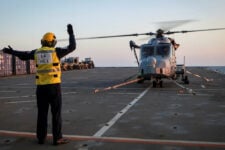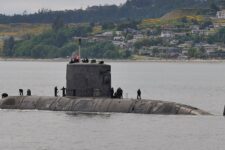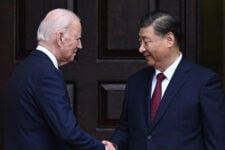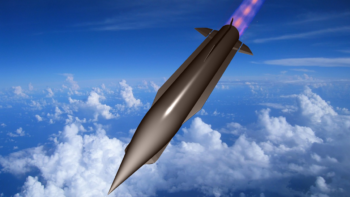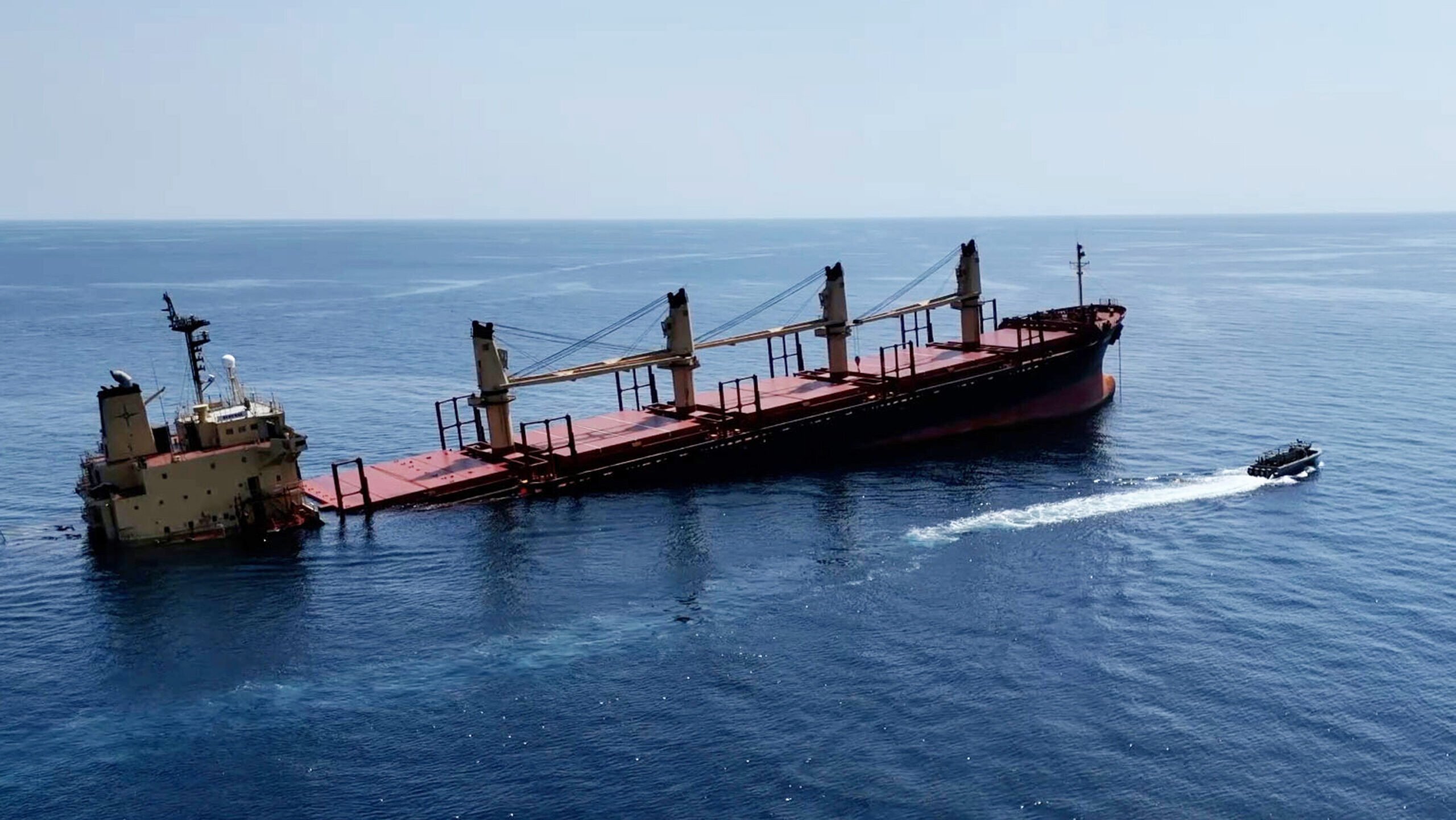
This handout photo provided by Yemeni Al-Joumhouria TV, shows the British-registered cargo ship ‘Rubymar’ sinking, after it was targeted by Yemen’s Houthi forces in international waters in the Red Sea, on March 3, 2024, in the Red Sea. (Photo by Al-Joumhouriah channel via Getty Images)
DUBAI — The ongoing strikes on ships in the Red Sea by Iranian-backed Houthi militias took their first lives on Thursday, with two sailors aboard the commercial vessel MV True Confidence killed by incoming fire. It’s a tragic, but almost inevitable, step in the Houthi campaign of launching missiles against commercial ships, as the Yemeni group attempts to disrupt trade and commerce in the region.
But the worst could still be coming, experts say, thanks to the impressive technological leaps the Houthis have shown in the realm of ballistic missiles.
The Houthis already made history in becoming the first group to successfully strike a naval vessel with a ballistic missile, and experts tell Breaking Defense the weapons have shown enough range to reach US bases in the region and threaten strategic choke points in the Middle East. Making matters worse: analysts warn it is likely that America’s premiere challengers, China and Russia, are studying how the weapons have succeeded and what danger they pose to US air defenses, in an effort to find a chink in Western armor.
It’s almost dizzying to try and keep track of the number of strikes by the Houthis. A Reuters analysis from Feb. 2 listed 30 attacks, but that number has increased since then, including on March 5 against a Swiss-flagged ship carrying containers. Those strikes come with a variety of systems, and what stands out specifically to experts is the use of ballistic missiles, as opposed to drones or cruise weapons.
The Houthis’ recent use of ballistic missiles to target merchant vessels signifies a first in the history of missile warfare, a number of experts contacted by Breaking Defense agreed. “Previously, there were others to have developed and tested anti-ship ballistic missiles — most notably Iran, Russia, China, and North Korea. But until the recent wave of Houthi strikes in the Red Sea, they were never used in actual combat,” said Sitki Egeli, former director of international affairs at the Turkish Undersecretariat for Defense Industries, who is currently a Professor at Izmir Economics University.
ANALYSIS: Houthi targeting of Israel suggests new, longer-range missile in play
The Houthis are an Iranian-armed group that has been vying for power in Yemen ever since it uprooted the internationally-recognized government in Sanaa in 2015. The group has been at war with a Saudi Arabian-led alliance, but since the Gaza conflict began, have taken on an increasingly adventurous posture towards US-aligned forces in the region. Their tool of choice, increasingly, has been Iranian-supplied ballistic missiles.
“A key element to Iranian regional strategy in recent years has been proliferating advanced missile technologies among its proxy and partner militias. Iran works to great lengths to smuggle missile parts to groups across the region, which in turn means that Iran’s so-called ‘Axis of Resistance’ can now threaten its adversaries from multiple cardinal directions at once,” said Andie Parry, a Middle East Security Program Researcher at the Institute for the Study of War.
Parry told Breaking Defense, “Iran has long used its drone and missile arsenals to threaten commercial traffic around the Persian Gulf and Strait of Hormuz. The Houthis are not only using Iranian-sourced munitions for their attacks but also taking a page directly from the Iranian playbook.”
The United States is leading an international alliance to protect merchant ships crossing the Red Sea and Bab Al-Mandab. The alliance, known as “Operation Prosperity Guardian” has shot down many Houthi missiles and drones, and carried out strikes deep into Houthi territories targeting missile sites, launch-pads, radars and other infrastructure.
Off The Shelf Accuracy
The fact the Houthis — a non-state actor who had been viewed as a contained threat in the region — were able to use ballistic missiles in this way caught many by surprise. But experts say that in retrospect, the warning signs were there, particularly given the availability of commercial off-the-shelf (COTS) dual-use parts.
“Recent advances in widely-available dual-use and COTS technologies and components gave rise to a new generation of ballistic missiles with accuracies down to meters or tens of meters. This has transformed ballistic missiles into tactically useful weapons,” Egeli told Breaking Defense.
RELATED: Why the European Union and United States are leading ‘parallel’ security operations in the Red Sea
“The Iranians have adeptly executed such modifications to missiles and have imparted this expertise to their regional proxies, including the Houthis,” said Abbas Dahouk, a retired US Army colonel who was senior military adviser on Middle East Affairs at the State Department.
Iran itself has increased its use of ballistic missiles tactically. Shaan Shaikh, a fellow at the Center for Strategic and International Studies, pointed out that “we’ve also seen Iran use ballistic missiles in combat. In January 2020, for example, Iran struck US troops in Iraq in response to the US killing of IRGC leader Qassem Soleimani.”
Some experts believe export control regimes on dual-use technology should be revised to be more robust in light of recent revelations.
“Iranian and North Korean missiles all have a significant amount of western technology in them. Some of the items are not commercially ubiquitous,” said David DesRoches, associate professor at National Defense University. “Restrictions and sanctions on dual-use technology need to be continually updated and enforced to prevent tech moving and to keep ahead of a very nimble sanctions evasion effort.”
“Iranian ballistic missiles incorporating components and subsystems of western produce or origin — most notably electronic components used in navigation, guidance and control systems — is a well-established fact,” said Egeli. “Stopping the flow of such components and products, as well as the relevant technical know-how is very difficult, if not altogether impossible. Most of those products are in wide-scale circulation in commercial markets all around the world”
Ballistic Missiles Give New Range For Threat
The range of the Houthi ballistic missiles have increased significantly over the past few years. In January 2022, the Houthis fired ballistic missiles against the UAE capital Abu Dhabi, which were intercepted by U.S. Patriot missiles. Since the Oct. 7 attacks, Israel has on more than one occasion intercepted Houthi ballistic missiles near its Red Sea port city of Eilat, which is over 1,500 kilometres from Yemen.
Moreover, Iran has proliferated ballistic missiles to all its proxies in the region and not just the Houthis, which means Tehran can use these proxies to target the bases and assets of the US and its allies all over the Middle East and North Africa region.
RELATED: How to counter the Houthi threat at sea
“Several Iranian-backed actors, such as Lebanese Hezbollah, the Houthis, and various Iraqi militias, operate some of these Iranian-provided ballistic missiles,” said Parry.
“The Houthis are not the only non-state actor armed with ballistic missiles. The Lebanese group Hezbollah has showcased these weapons in parades and propaganda, and Iran-backed militias in Iraq are also reported to have short-range ballistic missiles,” Shaikh said.
This range and accuracy of ballistic missiles operated by the Houthis and other Iranian proxies technically place all three strategic choke points in the Middle East — Bab Al-Mandab Strait, Hormuz Strait and the Suez Canal — within reach. Along with the other Iranian proxies, all US bases in the region are practically already within range.
But the threat of the Houthi anti-ship ballistic missile attacks extend beyond threatening the choke-points.
According to Parry, “The value of the Houthi’s using ballistic missiles is that the Iranians, Houthis, and other US adversaries can see US air defenses operate in real time and calibrate a strike package that is more likely to get through. They are essentially getting the opportunity to test and refine their approach to using different combinations of munitions to evade and overwhelm US defense systems.”
The growing relations in all fields, especially defense, between Iran, Russia, and China have raised concerns of an axis being developed that will challenge the U.S. and its Western allies globally. The navies of the three states hold annual naval exercises, with one coming up in a few weeks.
It stands to reason that the Russians and Chinese are watching closely to see how US and Israeli-made systems intercept the weapons the Houthis are firing. In essence, these strikes are doing R&D testing for Moscow and Beijing — an indirect threat, but a threat nonetheless, from the proliferation of these ballistic weapons in the region.
CORRECTION 3/11/24 at 3:34 PM eastern: This story has been updated to correctly describe the roles of Sitki Egeli and Shaan Shaikh.
TAI exec claims 20 Turkish KAAN fighters to be delivered in 2028
Temel Kotil, TAI’s general manager, claimed that the domestically-produced Turkish jet will outperform the F-35 Joint Strike Fighter.

